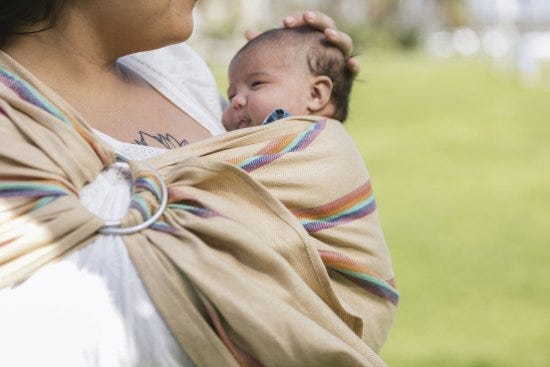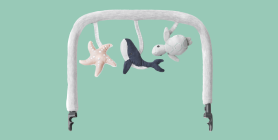Carrying the Future | Baby Carriers, a Brief History

Baby carriers have been an integral part of child-rearing practices across cultures and centuries. These ingenious devices have allowed parents to carry their infants safely, fostering a close bond and facilitating daily activities.
The concept of babywearing dates back thousands of years. In ancient civilizations such as Egypt, China, and Indigenous communities worldwide, caregivers used a variety of materials to secure their infants to their bodies. These early carriers were often simple wraps or slings made from cloth, leather, or woven plant fibers.
The benefits were apparent even in ancient times. Babywearing allowed parents to tend to their daily chores, gather food, or travel while keeping their infants close and safe. It also provided essential skin-to-skin contact and promoted emotional bonding.
In North America, Native American tribes used cradleboards as a traditional baby carrier. These wooden frames with fabric or leather wrapping offered protection from the elements and allowed mothers to comfortably carry their babies while working or traveling. Cradleboards played a significant cultural role, reflecting the tribes' values and traditions.
The Modern Revolution
The mid-20th century marked a turning point in the evolution of baby carriers. Dr. Benjamin Spock, a renowned pediatrician, endorsed babywearing as a way to promote attachment and reduce crying in infants. This endorsement sparked renewed interest in baby carriers, leading to the development of more structured and ergonomic designs.
Buckle Carriers, Mei Tais, and More
 In the 1960s and '70s, buckle carriers gained popularity. These carriers featured adjustable straps and buckles, providing a more secure and comfortable fit. On the other side of the globe, Mei Tais, inspired by Asian carriers, were introduced to the Western world. These carriers combined the simplicity of traditional wraps with the convenience of modern materials and design.
In recent years, traditional wraps and ring slings have made a comeback. They offer the versatility and customization of wrapping techniques while incorporating modern materials and features. This resurgence has given parents more choices to find the perfect carrier that suits their needs and style.
In the 1960s and '70s, buckle carriers gained popularity. These carriers featured adjustable straps and buckles, providing a more secure and comfortable fit. On the other side of the globe, Mei Tais, inspired by Asian carriers, were introduced to the Western world. These carriers combined the simplicity of traditional wraps with the convenience of modern materials and design.
In recent years, traditional wraps and ring slings have made a comeback. They offer the versatility and customization of wrapping techniques while incorporating modern materials and features. This resurgence has given parents more choices to find the perfect carrier that suits their needs and style.
The Rise of Soft Structured Carriers
The late 20th century and early 21st century saw a surge in research and innovation in baby carrier design. Ergonomics became a central focus, with carriers designed to provide proper support for both the baby and the wearer. Ergonomic baby carriers evenly distribute the baby's weight and support the baby's natural spine and hip development.
Soft Structured Carriers (SSCs) became a sensation in the 2000s. These carriers feature padded shoulder straps and a padded waistband for optimal comfort. They often include adjustable settings to accommodate newborns through toddlers.
The history and evolution of baby carriers reflect the enduring importance of keeping our infants close while adapting to the changing needs and preferences of caregivers. From ancient cloth wraps to soft structured carriers, baby carriers continue to evolve, allowing parents to nurture their babies and build strong bonds while staying hands-free and mobile. Whether you prefer the simplicity of a wrap or the convenience of a structured carrier, the options available today ensure that you can find the perfect baby carrier to suit your lifestyle and needs.
Here at Ergobaby, we love that we get to play a part in ever evolving history of babywearing around the world. For 20 years now, we’ve been thoughtfully designing carriers that meet the needs of parents right where they are - starting with the very first Ergobaby, created by a mother herself.
 Like a micro history of baby carriers, our Ergobaby carriers have evolved over the years too.
Like a micro history of baby carriers, our Ergobaby carriers have evolved over the years too.
[gallery size="medium" ids="18374,18375,18369,18373"]
Today (along with our sister brand, Tula) we get to offer parents a variety of choices that meet their unique needs and style! Whether it’s for cozy days at home or traveling around the world, there is something for everyone.

 In the 1960s and '70s, buckle carriers gained popularity. These carriers featured adjustable straps and buckles, providing a more secure and comfortable fit. On the other side of the globe, Mei Tais, inspired by Asian carriers, were introduced to the Western world. These carriers combined the simplicity of traditional wraps with the convenience of modern materials and design.
In recent years, traditional wraps and ring slings have made a comeback. They offer the versatility and customization of wrapping techniques while incorporating modern materials and features. This resurgence has given parents more choices to find the perfect carrier that suits their needs and style.
In the 1960s and '70s, buckle carriers gained popularity. These carriers featured adjustable straps and buckles, providing a more secure and comfortable fit. On the other side of the globe, Mei Tais, inspired by Asian carriers, were introduced to the Western world. These carriers combined the simplicity of traditional wraps with the convenience of modern materials and design.
In recent years, traditional wraps and ring slings have made a comeback. They offer the versatility and customization of wrapping techniques while incorporating modern materials and features. This resurgence has given parents more choices to find the perfect carrier that suits their needs and style.
 Like a micro history of baby carriers, our Ergobaby carriers have evolved over the years too.
[gallery size="medium" ids="18374,18375,18369,18373"]
Today (along with our sister brand, Tula) we get to offer parents a variety of choices that meet their unique needs and style! Whether it’s for cozy days at home or traveling around the world, there is something for everyone.
Like a micro history of baby carriers, our Ergobaby carriers have evolved over the years too.
[gallery size="medium" ids="18374,18375,18369,18373"]
Today (along with our sister brand, Tula) we get to offer parents a variety of choices that meet their unique needs and style! Whether it’s for cozy days at home or traveling around the world, there is something for everyone.
























